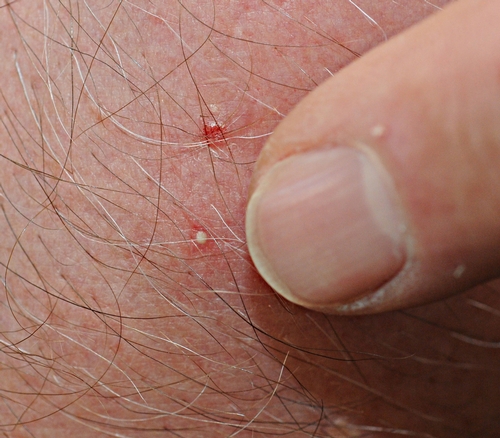- Author: Kathy Keatley Garvey
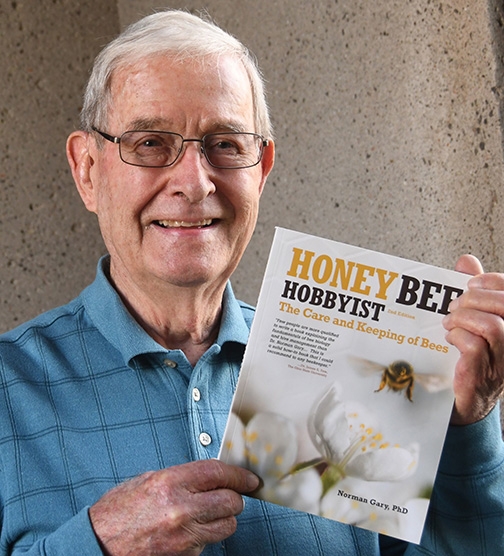
When folks hear about the 70-year beekeeping/bee wrangling career of 85-year-old apiculturist Norman Gary, emeritus professor of entomology at the University of Davis, they ask:
"How many times have you been stung?"
Let's see, can you guess?
Gary, internationally known as "The Bee Man," began keeping bees at age 15 in Florida. His career includes hobby beekeeper, commercial beekeeper, deputy apiary inspector in New York, honey bee research scientist, entomology professor, author, bee wrangler and Guinness World record holder.
He once trained bees to fly into his mouth to collect food from a small sponge saturated with artificial nectar. His holds the Guinness World record (109 bees inside his closed mouth for 10 seconds) for the stunt. He's also the person behind the "bee suit" record in the Guinness World Records; Gary clustered more than 87 pounds of bees on a friend.
So, how many times has he been stung?
"I didn't keep records, of course," the Sacramento-area resident understandably points out. "Many thousands for sure! I was probably stung over a thousand times during one summer as an apiary inspector in New York state. We didn't wear gloves."
"People don't understand that a sting is not very significant if you remove the stinger within several seconds before much venom is injected," he says. "So we worked fast and took chances that resulted in more stings but we didn't mind that much because we developed a strong tolerance, without significant reactions, and removed the stings instantly."
"During my long career, I manipulated much greater numbers of colonies more frequently than most bee researchers because my research was field-oriented. So several hundred stings per year for 70 years is a lot of stings. My guess is that the total number of stings would be around 20,000. Unfortunately the sting number estimates were greatly exaggerated during some of my TV shows. But that is show biz!"
Gary, author of the newly published Honey Bee Hobbyist: The Care and Keeping of Bees, second edition, writes in his book that "most people have an exaggerated sense of dread concerning bee stings due to a wealth of misleading negative information in the media."
Bees are defensive, not aggressive, he says. "Defensive behavior happens only when you are very close to the hive. Bees foraging on flowers or collecting water certainly have the ability to sting, yet they behave as if hey are totally defensiveless. They will fly away in response to the slightest disturbance. Remember, a bee that has stung dies within a few seconds and the colony benefits only if this sacrifice is made in defense of the colony."
Gary, who holds a doctorate in entomology from Cornell University, joined the UC Davis entomology faculty in 1962, retiring in 1994 after a 32-year academic career. He has authored more than 100 publications, including scientific papers, book chapters and popular articles in beekeeping trade journals. During his professional bee wrangling career spanning four decades, “The Bee Man” served as a consultant and bee stunt coordinator for 17 movies, 70 TV shows and six TV commercials. Among his credits: the movie, “Fried Green Tomatoes” and TV appearances with Johnny Carson and Jay Leno.
In his book, Gary covers activities inside and outside the hive, reproduction, management of colonies, honey and other products, urban beekeeping, beekeeper education (he mentions the UC Davis-based California Master Beekeeper Program), and entertaining with bees, among other topics.
That's in addition to colony defense and sting prevention. "The Bee Man" zeroes in on stinging behavior, getting stung, minimizing the effects of stings, reactions to stings, and why bees sting.
Why do they sting? "Defensive behavior is necessary for their survival, to protect the colony and the stored honey and pollen."
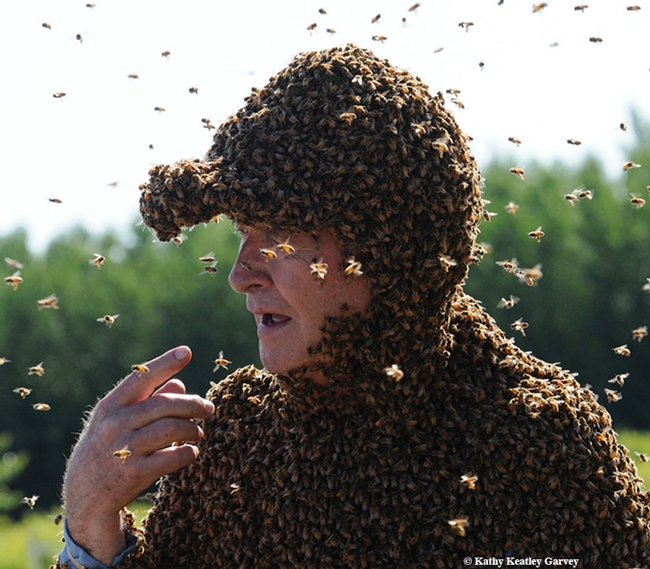
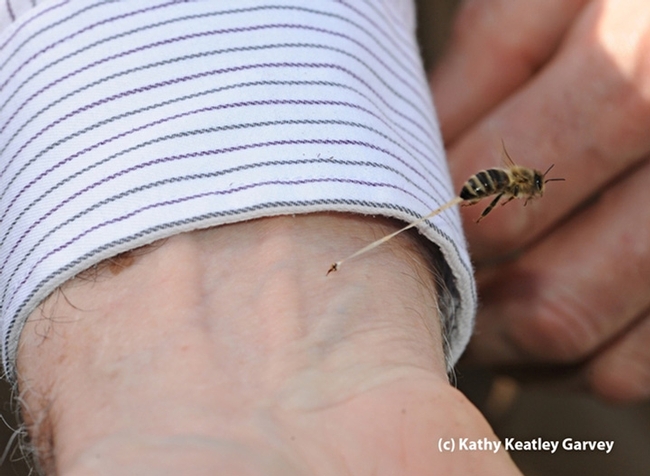
- Author: Kathy Keatley Garvey
It’s raining in northern California like the proverbial cats and dogs--and all the more reason to think of vacations.
Extension apiculturist Eric Mussen, member of the UC Davis Department of Entomology faculty, received a query last week from a family planning a camping trip to a public park in the Midwest.
A daughter is allergic to bee stings, so the family wanted to know two things:
1. Is there any way to find out what a bee population is in a specific area?
2. How can we avoid bee stings?
His answers are informative:
Is there any way to find out what a bee population is in a specific area?
Usually, the only records that are kept deal with the number of colonies registered by the beekeepers in a state once a year. If the beekeepers are commercial beekeepers, they are likely to move the colonies around for purposes of crop pollination or producing honey crops. Unless you knew all the beekeepers and their patterns of operation, there is no way to know where the colonies are.
If this is a good honey producing area, beekeepers might be moving their bees into it. You could call the park (if it is one) and see if they allow beekeeping on the park grounds.
Even if they don't, if there is good bee forage in the area (nectar and pollen), some honey bees are apt to be living around the area in "feral" colonies--not managed by anyone.
How can we avoid bee stings? Best preventative measures?
Honey bees do not tend to sting anything very far from the nesting location, unless you happen to step on one, etc. They are busy collecting water, nectar, pollens, or propolis (plant resins they use to glue things in the hive.) If something comes near the nesting location, and the bees respond to the approaching threat, then there might be some stinging.
What are the best preventative measures? This pertains to wasps, too, which sting more people in the woods than honey bees ever do. Keep your eyes open for "directed" flight by insects in an out of a specific spot. That is likely to be the nest entrance. Keep away from there.
If bees or wasps come flying out toward you, don't swing at them or try to blow them away from your face. You'll get stung immediately. If you are not yet stung, just stand very still for a moment, then ease yourself out of the area with no flailing or swinging of the arms, etc.
Put a lot of distance between you and the nest without running.
If they are all over you and stinging, then run first and work on the stings later. Honey bee stings stick in your flesh and give off "alarm pheromone," which leads to more stings in the same place. You do not want to continue to be a target.
If stung, look for the sting when you get a chance. If it is honey bees, the sting will be there. Scrape it off with a finger nail, before all the venom is pumped into the skin.
Honey bees are attracted more to yellow and blue than to other colors. Honey bees treat red and black as black. Black is bad if bees are stinging in the area. Pastel and white colors usually are best around bees.
Honey bees are attracted to odors reminiscent of lemon and are shocked by the smell of bananas--just like their alarm odor. (The aroma of bananas is similar to the scent of a bee's alarm pheromone.)
Final thought, even if there are bee hives or nests around, hardly anyone ever gets stung by them. They do their thing and you do yours, and there should not be any conflict under normal circumstances.
***For more information on bee stings, read the bee sting advice that appears in his newsletter, from the UC Apiaries, a publication Mussen launched in 1976. He also writes the equally informative Bee Briefs. These publications are archived on the UC Davis Department of Entomology Web site.

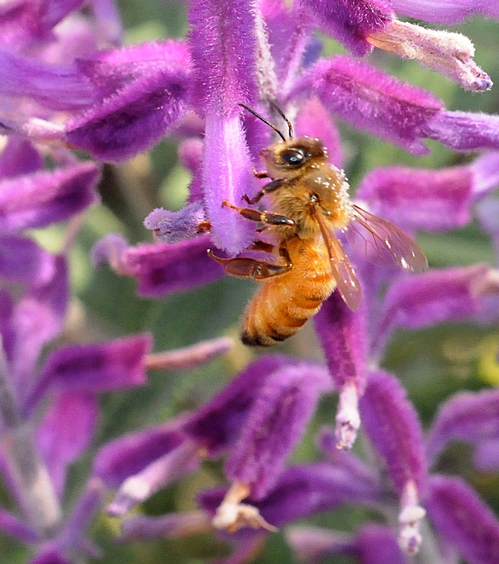
- Author: Kathy Keatley Garvey
Beekeepers consider stings just a part of their job.
However, say the word "bee" and John Q. and Jane Q. Public may not think about the pollination of fruits, vegetables and nuts. Or the end product: honey.
The bee conjures up the "S" word: sting.
Of the scores of questions that Extension Apiculturist Eric Mussen has fielded since 1976 (when he joined the UC Davis Department of Entomology faculty), many relate to bee stings.
Here are his answers to some of the most commonly asked questions:
1. Can a honey bee sting kill you?
If a person is highly sensitized to honey bee venom, one sting could be fatal, causing anaphylactic shock. Otherwise, it is just painful and likely to cause some swelling and local tenderness that will last for two or three days.
2. How do you treat a honey bee sting?
Try to remove honey bee stings as quickly as possible, since venom is pumped from a sting into the victim for 45-60 seconds. Stings are easily scraped off with a fingernail. If many honey bees are stinging, leave the area quickly and deal with the stings when you are out of range of the defensive area (about 100 feet with European honey bees, but up to ¼ mile – 1,320 feet – with Africanized honey bees). The pain can be reduced a bit by putting ice on the sting site, but the stabbing pain backs off fairly quickly without any treatment.
3. Can a honey bee hear you?
Honey bees do not have sensory organs that can pick up sounds that we can hear. They are very sensitive to vibrations. They feel us walking toward the nesting site before we get there.
4. Why do beekeepers use smokers when they visit their beehives?
The smoke from the smoker has three effects on the bees. First, it prevents the guard bees from liberating much “alarm pheromone” (smells like bananas) in the hive. Second, it prevents “soldier” bees in the hive from smelling the pheromone that has been secreted. Third, it causes many bees to fill up on honey. Despite the wives’ tales to the contrary, there is no reason to believe that the bees “think” there is a fire or that bees full of honey cannot sting.
5. Can honey bees see color?
Yes, honey bees can see nearly all the colors we see. They cannot see red, which looks black to them. They can see into the UV wavelengths a ways, which is beyond our limit at purple. UV looks black to us.
6. Do honey bees need to eat meat?
No. Unlike wasps, honey bees derive nearly all the important ingredients in their diet from pollens. Pollens contain protein, fats, vitamins, minerals, carbohydrates, sterols, and many plant-derived antioxidants. No single pollen contains all the essential ingredients, so colonies do best where a good mix of attractive flowers are available. Nectar, the dilute sugar syrup honey bees collect from flowers, contains mostly sugar, an energy food. The flavor and color of honey depend upon the source of the nectar from which it is condensed.
There you have it: The A, Bee and C of the most commonly asked questions.
Bottom line: Sure, bees can and do sting, but our survival depends on them. Bees pollinate one-third of the food we eat (fruits, vegetables and nuts). They pollinate some 100 crops in California, including about 700,000 acres of almonds.
“The value of California crops pollinated by bees is $6.1 billion,” Mussen says.

